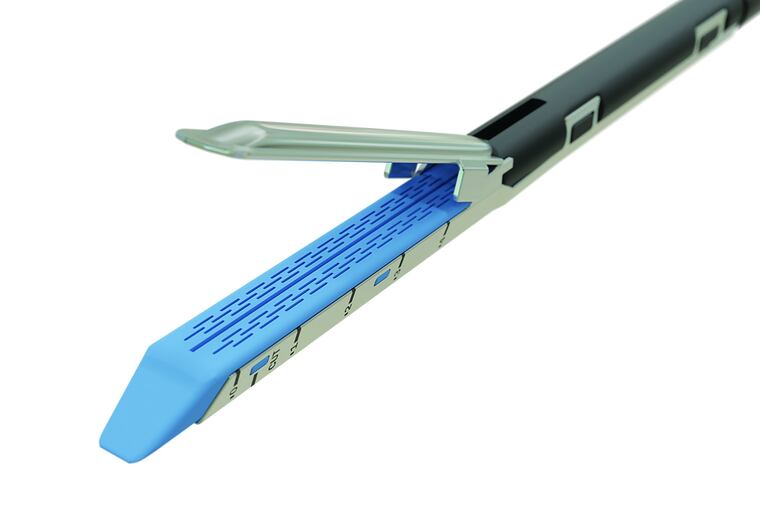Top 10 health tech hazards to watch in 2020, according to Philly-area safety institute
Among other things, beware of staplers and loose nuts and bolts.

The lowly surgical staple, which is probably not among your health care worries, tops ECRI Institute’s annual list of health technology hazards for 2020.
While the staplers themselves can malfunction, problems more often start with the people using the devices, according to investigators at the Plymouth Meeting company that evaluates the safety, quality, and cost effectiveness of health care. They pick staples that are too big or too small, try to staple tissue that is too thick or thin, or try to staple over another instrument or clip. Stapling mistakes can be fatal, usually because of bleeding. Complications can occur immediately or well after surgery.
Considering how much the staplers are used, problems are relatively few, said Julie Miller, ECRI senior project engineer. But “it can be highly problematic if there is an incident.”
This is the 13th edition of the annual report, which is meant to alert health care leaders to problems that ECRI thinks should be their top worries in the coming year, said Robert Schluth, an ECRI health-care technology analyst. The latest one also raises the alarm about the use of ultrasound, home dialysis, alarm fatigue, and loose nuts and bolts.
The top hazards are chosen by ECRI employees and are based on their investigations, tests, or observations, along with published reports from others. They weigh how serious consequences can be to patients or employees, whether problems can spread, and whether a hazard is likely to attract negative attention from the media or regulators. To make the list, all of the hazards must be at least partially preventable.
Staples have been on the list before, but were moved up this year because there are continuing reports of problems and the “reason for the reports doesn’t seem to be evolving,” Miller said.
» READ MORE: The tiny device that can mean surgical success or failure
ECRI said the Food and Drug Administration recently announced that there had been more than 100,000 incident reports on surgical staplers since 2011. Those included 412 deaths, 11,181 serious injuries, and 98,404 malfunctions. The FDA is considering reclassifying surgical staplers so that they are regulated more stringently, Miller said.
Miller said there are two major manufacturers of staplers and each produces multiple types. Knowing how to use one brand does not mean you know how to operate the other. The various sizes of staples surgeons choose are color-coded, but the manufacturers use different colors for similar staples. ECRI recommends that people who use the staplers practice and read the instructions before using them in surgery.
The rest of the list includes:
Smaller, cheaper ultrasounds that can be used at the bedside. Jason Launders, ECRI’s director of operations, said these are often found now in emergency departments but are also in many other settings. They are often used to detect internal bleeding. “These are very inexpensive devices, and they’re turning up everywhere,” he said. The machines themselves are very safe. The hazard is that poorly trained workers may miss problems or not get ultrasound tests in instances where they are now “standard of care.”
Infection risks from inadequate sterilization in medical and dental offices.
Overuse of central venous catheters in home dialysis. These catheters are not recommended for long-term use because of the threat of infection and blood clots. Home dialysis is increasing, but Launders said patients who need the catheters may not be appropriate for home dialysis.
Overuse of unproven robotic surgery. It’s not always better than conventional surgery, ECRI says.
Alarm overload. Health-care workers are bombarded with not only alarm sounds from machines, but also phone notifications and pop-ups on electronic medical records. Facilities need a global approach that considers how many notifications workers are receiving to “prevent the kind of cognitive overload that can distract or desensitize clinicians or prompt them to use improper notification settings, all of which can lead to missed notifications and patient harm,” the report concludes.
Home cybersecurity. As more medical devices move into the home and rely on home computer networks, health systems need to understand that those networks may be vulnerable to hacking.
Better records on internal implants that can cause problems during MRIs.
Medication dose timing problems when doctors' orders conflict with electronic medical records.
Loose nuts and bolts on medical equipment. ECRI said failing to pay attention to loose parts can lead to “catastrophic device failures and severe injury.” It has published nearly two dozen reports over the last two years about medical equipment with loose fasteners. “Affected equipment ranged from baby scale carts (putting newborns at risk) to massive angiography systems (which could cause devastating harm to anybody under a falling component),” the report said.